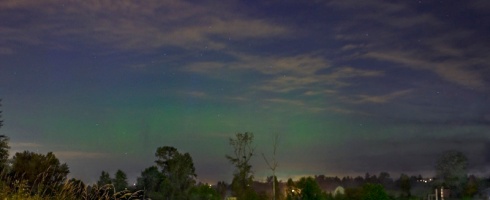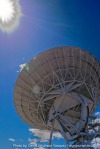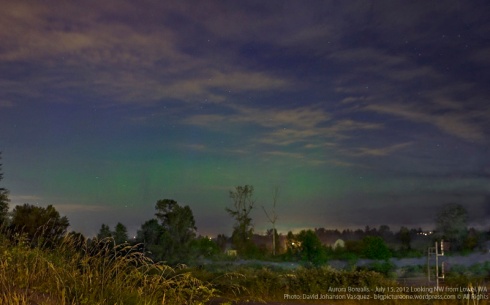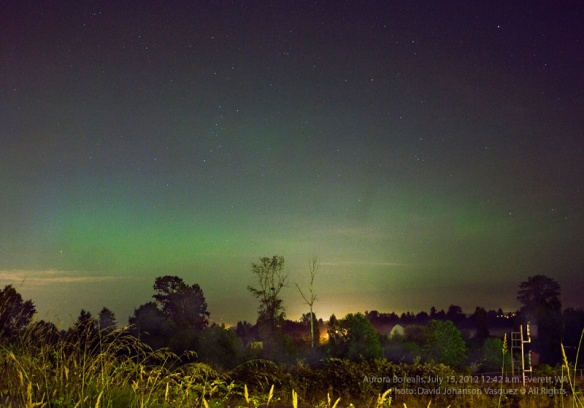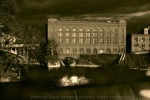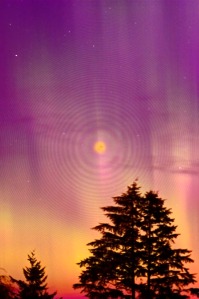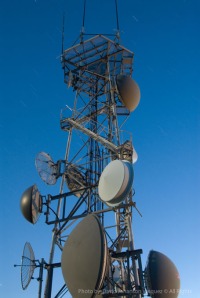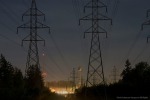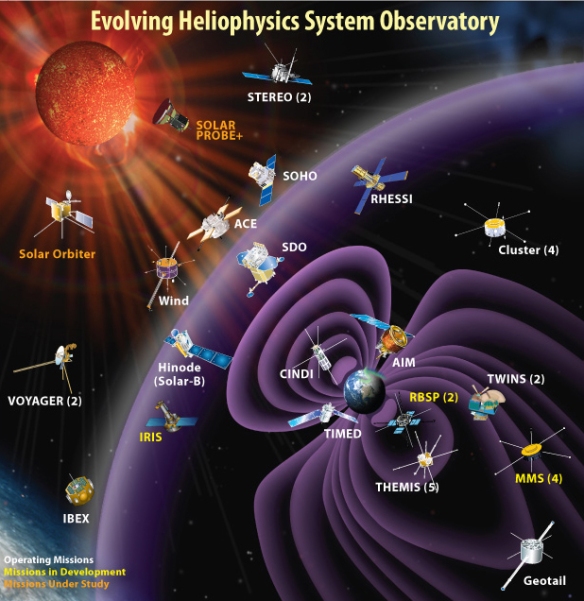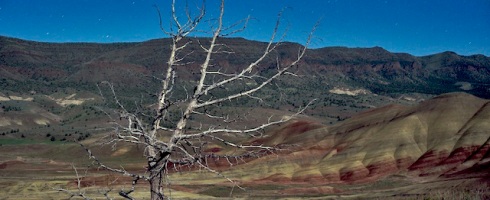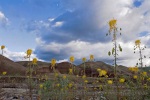
Multimedia essay by: David Johanson Vasquez © All Rights — Second Edition
My photo wingman, Rick Wong and I headed into the heart of darkness in quest of the Perseid meteor showers. Mount Rainier National Park—was our ultimate destination. We chose the iconic, volcanic landmark for framing an infinite field of stars, which we believed was far from the glare of city lights. Traveling at night in Rick’s new Ford Fusion, using the hybrid’s voice recognition, made it easy to arrive at the park without using a map. Reaching our destination, luminous sparkling stars lit up the still night, but we were surprised with some uninvited competition, which nearly stole the show.
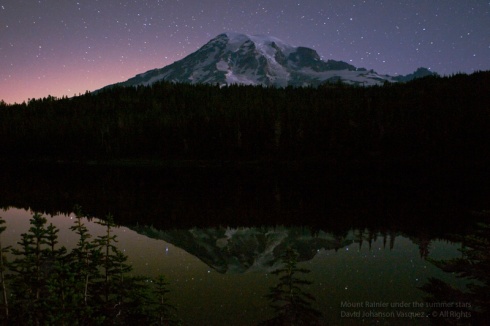
A stunning view of Mount Rainier reflected in Reflection Lake, with the summer stars overhead. The pink and orange glow on the left side of the mountain is light pollution emitted from the City of Tacoma, approximately 65 miles northwest.
We found an ideal location above Reflection lake, with the Cascade Mountains’ most famous stratovolcano in the background. An unexpected warm light was glowing behind Mount Rainier, which I reasoned, was a faint remnant from the earlier sunset. However, the sun had set at least four hours earlier, so it couldn’t be the source of the illumination. Rick suggested “its light coming from the City of Tacoma,” located about 65 miles away. During a 20-second long exposures used to take images of the snow-capped mountain, I began thinking about the effects caused by light pollution.
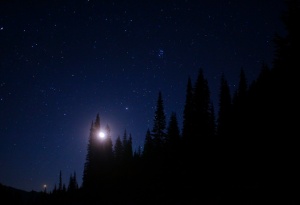
With a bright moon rising, we worked fast to keep up with the changing light, until its intensity eventually overpowered the stars.
With the moon steadily rising behind us, it too was causing us to shift focus on what to photograph. Like a giant diffuse reflector, the moon projected soft filtered sunlight onto a previously dark, formless landscape. As the moonlight overwhelmed the intensity of the starlight, it removed the opportunity for crystal clear views of the Milky Way, as well as faint meteor sightings. Being photo opportunist, we used the moonlight opportunity to reveal shadow-detail on the south face of Rainier.
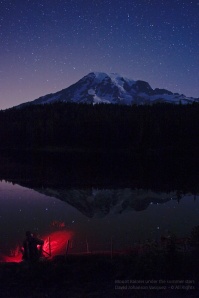
The photographer appears in the dark, like some sorcerer conjuring an intense red light before Mount Rainier and her crown of stars above.
A Peaceful Paradise Lost
There’s a tranquil feeling while in the process of taking long exposures at night; it’s normally quiet with minimal distractions to overwhelm the senses or interrupt your focus. I personally enjoy these rare opportunities of solitude, to visualize an image using a minimal—Zen like perspective.
Distractions can be disruptive during these in-the-now-moments, as when cars coming around corners with intense, high-beam headlights. More than once, clusters of cars with high beam lights appeared… just as the moon illuminated the mountain’s reflection onto a perfectly still lake. I quickly used my hands, in an attempt to shield the lens from light flare. Finally, the cars diapered into the darkness with no approaching vehicles until dawn.

Photo-illustration of the multiple effects of light sources which can cause light pollution by unintended distraction or spill-light.
Moving above the lake to find new angles for interesting compositions, I began to notice something, which I had not noticed before. Lights of various colors, were coming from photographers bellow me, created by their digital camera’s preview monitors and infrared sensors for auto focusing. With the low light-sensitive Nikon cameras I was using, their monitor lights appeared like a bright flare in my long exposure photos. Now, I had one more unwelcome light source to deal with, which required strategic timing in making exposures to avoid the glare.
Again, my thoughts returned to the issues of light pollution. I remembered back home when I wanted to photograph a full-moon at night and a neighbor’s floodlight lit up the backyard. Their floodlight forced me to find the last remaining isolated shadowed corner of the yard.
My reminiscing was cut short by a distant, but bright, pinpoint of light flashing from bellow Mount Rainier’s summit. Flashlights from mountain climbers near Camp Muir shined bright like lighthouse beacons in the semi-darkened rocks and glacier fields. Even the faintest light can shine bright at night as documented in World War II. Warships were forbidden from having any exterior lights on at night, including a lit cigarette, otherwise they could be spotted from great distances by enemy submarines.
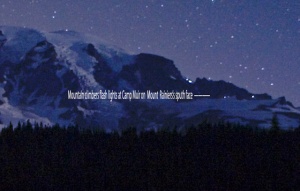
Lights from mountain climbers on the approach to the summit of Mount Ranier.
Encountering the Universe’s Brilliance
The improper, overuse of outdoor lighting has erased a fundamental and connecting human experience—encountering the universe’s brilliance with its galaxies and stars shining in the night sky! Making a visual contact with our own galaxy, the Milky Way, is one of the greatest shows seen from Earth.
In less than a century of civilization’s reliance on electric technology: two-thirds of the U.S., half of Europe and a fifth of people in the world—now live where they cannot see the Milky Way with the unaided eye. You can appreciate how we lost our stellar view by seeing aerial photos taken from orbiting spacecraft and the International Space Station. These startling images taken of Earth at night, reveals a man-made galaxy of artificial light, which cancels out much of the real ones in the sky above.
Some years back, I was a part-owner in a small recreational ranch, in Eastern Washington’s, Okanogan County. Brining friends over from Seattle, it was often nighttime when we arrived. The instant of exiting the cars, was a startling event as the Milky Way’s intensity of light overwhelmed your senses. The “ranch” was remotely located, at about 5,000 feet in the mountains, near the Canadian border and 30-miles from the closest town. Days would go by where we didn’t see a car or even hear a small airplane go overhead… it was one of the most refreshing experiences of my life, to perceive nothing except wind going through trees and seeing only starlight at night for hours at a time.
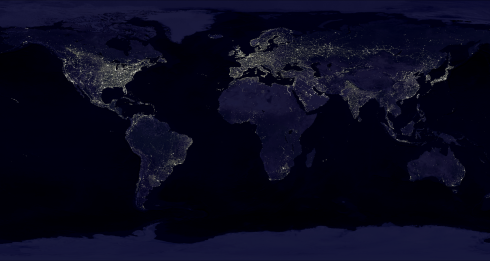
Image courtesy of NASA
A television interview with the director of a major observatory in Southern California recounted when Los Angeles had its last electrical blackout —people were calling 911 and his observatory, reporting of strange, bright objects in the night sky. Actually what the callers were seeing for the first time, was the natural light from intensely shining stars of the Milky Way.
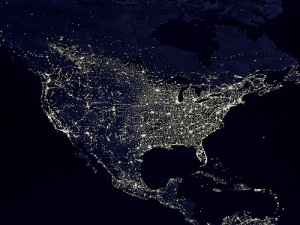
Image courtesy of NASA.
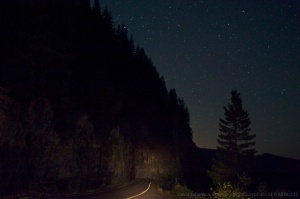
Besides forfeiting a life inspiring, wondrous view of the cosmos, there’s tangible losses associated with light pollution. Conservative estimates are 30 % of U.S. outdoor lighting is pointed skyward in the wrong direction, which wastes billions of dollars of electricity. The unnecessary practice of lighting clouds, burns more than 6 million tons of coal, which adds harmful greenhouse gas emissions, along with toxic chemicals into our atmosphere and water.
Further scientific studies indicate wildlife is suffering the ill effects of excessive urban lighting. The City of Chicago has taken measures to turn off or dim its high-rise lighting to enable migrating birds to continue normal migration patterns. An increase in species of insects attracted to light, along with rodent attraction to bright city lighting is a growing concern to many scientists.
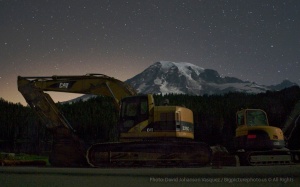
Heavy equipment product shots never look quite this good. Scheduled improvements to the viewing area above Reflection Lake, had some equipment taking a nap, before going to work when the sun came up.
Education Is the Solution to Light Pollution
The reason light pollution has continued to multiply is, we have grown accustomed to its seemingly benign expanding presence. After all, probably no one can point to a single case of a person killed from overexposure to light pollution? However, there is a correlation to growing health risk associated with overexposure to artificial light in the form of physical fatigue and damage to eyesight. In 2009, the American Medical Association established a policy, which supports the control of light pollution.
Municipal lighting codes are beginning to help define and eliminate unnecessary light pollution. Lighting enforcement can create a more pleasing environment, by reducing excessive urban lighting, which causes fatigue from glare and cuts down on unnecessary electric utility cost. Redirecting outdoor lighting away from the sky where it is needlessly wasted is a simple and easy solution.
Installing motion detector security lights are another efficient and productive mitigation strategy. For security purpose, a light which is triggered by motion is much more effective for crime prevention than a continuous floodlight. Motion detector lights have a clear advantage of focussing our attention onto an area where there’s a sudden change from darkness to bright-light.
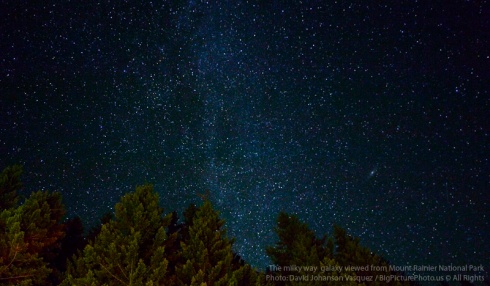
The Milky Way is what we should be able to see at night if it was not for unrestricted light-pollution. You can see the Andromeda Galaxy in the right 1/3 of the frame. Nikon D700 – Nikkor 28mm lens @ F3.5 @ 20 seconds August 11 11:48 p.m.
The encouraging news is… the key to reducing light pollution is a simple matter of basic education and action. Public awareness of over-lighting requires a minimal expenditure, which will quickly pay for itself in energy savings and perhaps return the opportunity to experience one of the greatest shows seen from earth. ~
Light pollution glossary:
Urban Sky glow: the brightening of night skies over municipal and communities. Caused primarily from collective reflected light and poorly directed light, which is pointed upward.
Light trespass: light falling or spilling into areas where it is not intended. Also know as “spill light” such municipal streetlights, which go beyond indented illumination of street signs and sidewalks and lighting residential homes.
Glare: A direct, bright or harsh light, which causes discomfort or pain. The effects of glare can be reduced or eliminated with the use of a shield or filter.
Uplight: Light angled inappropriately upward towards the sky and serving no purpose. Uplift washes out the night sky and reduces opportunities for astronomers and stargazers to enjoy the beauty of the planets, moon and stars.
Clutter: Poorly planned, confusing and unpleasant use of multiple lights usually associated with urban or retail lighting. Retail business sometime competes by using overly bright, multicolored or pulsating light
Links to articles & related resources on light pollution:
http://www.darksky.org/assets/documents/is001.pdf
http://www.njaa.org/light.html
http://www.skymaps.com/articles/n0109.html
http://en.wikipedia.org/wiki/Light_pollution
http://ngm.nationalgeographic.com/geopedia/Light_Pollution
[contact-form][contact-field label="Name" type="name" class="GINGER_SOFATWARE_correct">/][contact-field label="Email" type="email" class="GINGER_SOFATWARE_correct">/][contact-field label="Website" class="GINGER_SOFATWARE_correct">/][contact-field label="Comment" type="textarea" class="GINGER_SOFATWARE_correct">/][/contact-form]
Tags: American Medical Association, Andromeda Galaxy, astronomy, astronomy photography, Auto technology, Canadian Border, David Johanson multimedia specialist, David Johanson Vasquez, David Johanson Vasquez Essay, David Johanson Vasquez Science Tech Tablet, Dramatic landscape photography, E-Learning, educational photography, essay on light pollution, exciting photos of the stars. famous stars photographed, fine art photography, Ford Fusion, galaxy, health risk associated with light pollution, how to photograph stars, how to photography, Information Technology, landscape photography, light pollution, light pollution awareness, light pollution education, light pollution links and resources, light pollution multimedia essay, light pollution remedies, Los Angeles black out, Low light photography, lowlight photography, Milky Way Galaxy, Mount Rainier National Park, night photography, Nikon Digital Cameras, noise pollution, Okanogan County, Pacific Northwest, Perseid meteor showers, pro photographer David Johanson Vasquez, professional photography, Reflection Lake, Rick Wong, Science Tech Tablet, spectacular photography, stars, stratovolcano, voice recognition, volcanoes, Web-Based E-Learning, WPLongposts, www.sciencetectablet.wordpress.com












